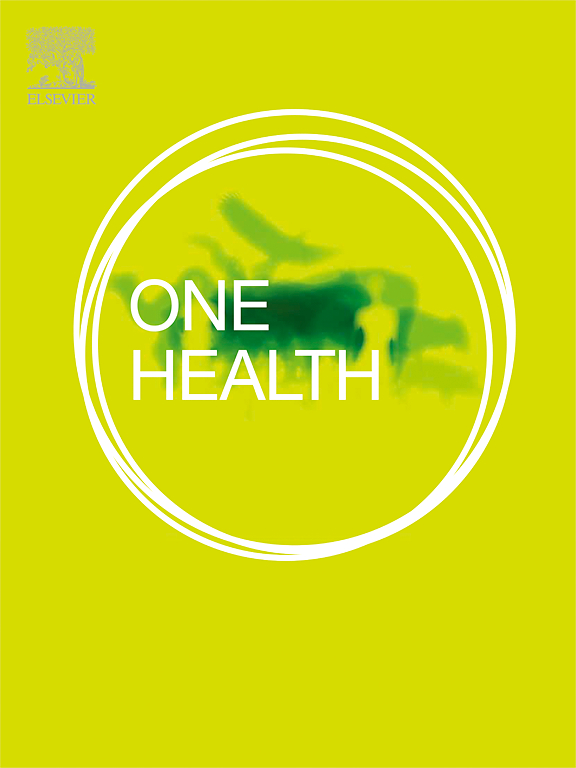在肯尼亚莱基皮亚进行的宏基因组测序调查了潜在的外溢,发现了蜱传病原体和一种新型布尼亚病毒
IF 4.5
2区 医学
Q1 INFECTIOUS DISEASES
引用次数: 0
摘要
蜱传感染继续构成全球公共卫生威胁,需要采取“同一个健康”方法才能成功缓解。我们利用基于纳米孔测序(NS)的未知宏基因组筛选策略,在肯尼亚中部跨越一系列人类-牲畜-野生动物相互作用增强的栖息地进行了横断面蜱虫筛选。如有必要,我们进一步使用聚合酶链反应(PCR)和序列独立单引物扩增(SISPA)进行靶向扩增和基因组鉴定。我们最初在7个物种的池和个体样本中筛选了44个蜱。在86.6%的样本中检测到与蜱相关的细菌,包括斑点热立克次体(13.3%)和柯谢氏菌样内共生菌,图兰弗朗西斯菌和机会性弗朗西斯菌,以及蜱相关的伯氏疏螺旋体。在93.3%的标本中检出病毒,其中以荆门蜱病毒(JMTV)最流行,80%的标本中检出病毒。后续的特异性PCR证实,75%的人检测到JMTV病毒,与NS中的病毒读取丰度相关。从sparsum Amblyomma蜱中组装了一个完整的JMTV基因组,该基因组显示了假定的结构和复制蛋白的保守基序。最大似然分析将病毒基因组置于所提出的东非-亚洲JMTV谱系中的一个不同的分支中。我们进一步调查了初步筛选过程中产生的病毒群,鉴定为伏尔日斯科蜱病毒(VSTV)。随后对来自11个蜱种的650只蜱进行NS和靶向PCR筛选,结果显示,JMTV在两眼蜱、透明蜱和鼻头蜱中流行率为12.3%。后续NS和SISPA生成病毒基因组片段,编码推定的复制酶和糖蛋白前体。两两比较和系统发育表明,一种新型病毒(本文命名为Mpala蜱病毒)与VSTV相关,但不同于VSTV,位于布尼亚病毒属未分类成员中。总之,我们的方法为检测各种蜱传细菌和病毒提供了一种有效的策略,有助于鉴定机会性或内共生细菌以及新型病毒。本文章由计算机程序翻译,如有差异,请以英文原文为准。
Potential spillover investigated by metagenome sequencing in Laikipia, Kenya reveals tick-borne pathogens and a novel bunyavirus
Tick-borne infections continue to present a global public health threat, and require a One Health approach for successful mitigation. We conducted cross-sectional tick screening utilizing an agnostic metagenomic screening strategy based on nanopore sequencing (NS), in an area spanning a range of habitats with intensified human-livestock-wildlife interactions in central Kenya. We further used targeted amplification by polymerase chain reaction (PCR) and sequence independent single primer amplification (SISPA) for confirmation and genome characterization, as necessary. We initially screened 44 ticks across pooled and individual samples belonging to seven species. Tick-associated bacteria—including spotted fever Rickettsia (13.3 %) and Coxiella-like endosymbionts, Francisella turcica and Francisella opportunistica, and tick-associated Borrelia—were detected in 86.6 % of samples. Viruses were detected in 93.3 % of samples, where Jingmen tick virus (JMTV) was observed as the most prevalent virus, detectable in 80 % of samples. A follow-up specific PCR confirmed JMTV virus detection in 75 %, associated with viral read abundance in NS. A complete JMTV genome was assembled from an Amblyomma sparsum tick, that displayed conserved motifs of putative structural and replication proteins. Maximum likelihood analyses placed the virus genome within a distinct clade in the proposed East African-Asian JMTV lineage. We further investigated a virus contig generated during the initial screening, with limited identities to Volzhskoe tick virus (VSTV). Subsequent NS and targeted PCR screening in an additional collection of 650 ticks from 11 species revealed a JMTV prevalence of 12.3 % in Amblyomma, Hyalomma and Rhipicephalus species. Follow-up NS and SISPA generated viral genomic segments, encoding a putative replicase and glycoprotein precursor. Pairwise comparisons and phylogeny indicated a novel virus—herein named as the Mpala tick virus—which is related to but distinct from VSTV and placed among unclassified members of Bunyaviricetes. In conclusion, our approach provides an effective strategy to detect a wide range of tick-borne bacteria and viruses, facilitating identification of opportunistic or endosymbiotic bacteria as well as novel viruses.
求助全文
通过发布文献求助,成功后即可免费获取论文全文。
去求助
来源期刊

One Health
Medicine-Infectious Diseases
CiteScore
8.10
自引率
4.00%
发文量
95
审稿时长
18 weeks
期刊介绍:
One Health - a Gold Open Access journal.
The mission of One Health is to provide a platform for rapid communication of high quality scientific knowledge on inter- and intra-species pathogen transmission, bringing together leading experts in virology, bacteriology, parasitology, mycology, vectors and vector-borne diseases, tropical health, veterinary sciences, pathology, immunology, food safety, mathematical modelling, epidemiology, public health research and emergency preparedness. As a Gold Open Access journal, a fee is payable on acceptance of the paper. Please see the Guide for Authors for more information.
Submissions to the following categories are welcome:
Virology,
Bacteriology,
Parasitology,
Mycology,
Vectors and vector-borne diseases,
Co-infections and co-morbidities,
Disease spatial surveillance,
Modelling,
Tropical Health,
Discovery,
Ecosystem Health,
Public Health.
 求助内容:
求助内容: 应助结果提醒方式:
应助结果提醒方式:


